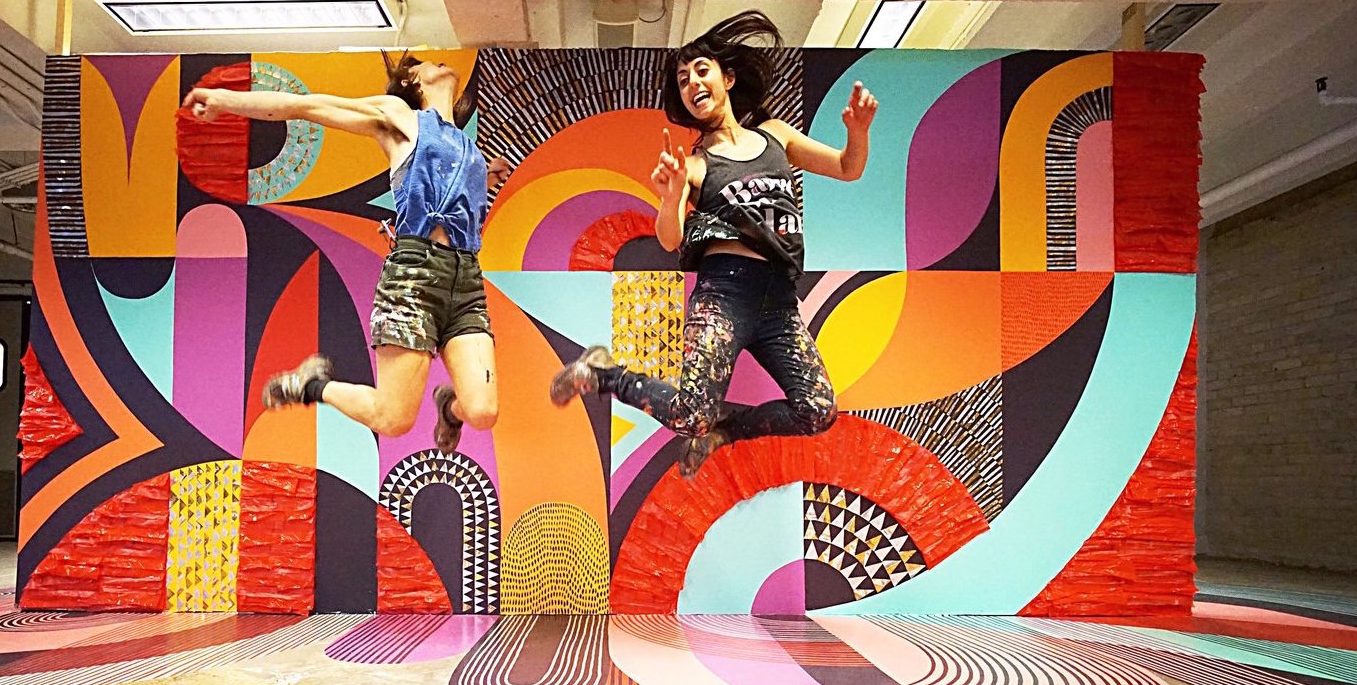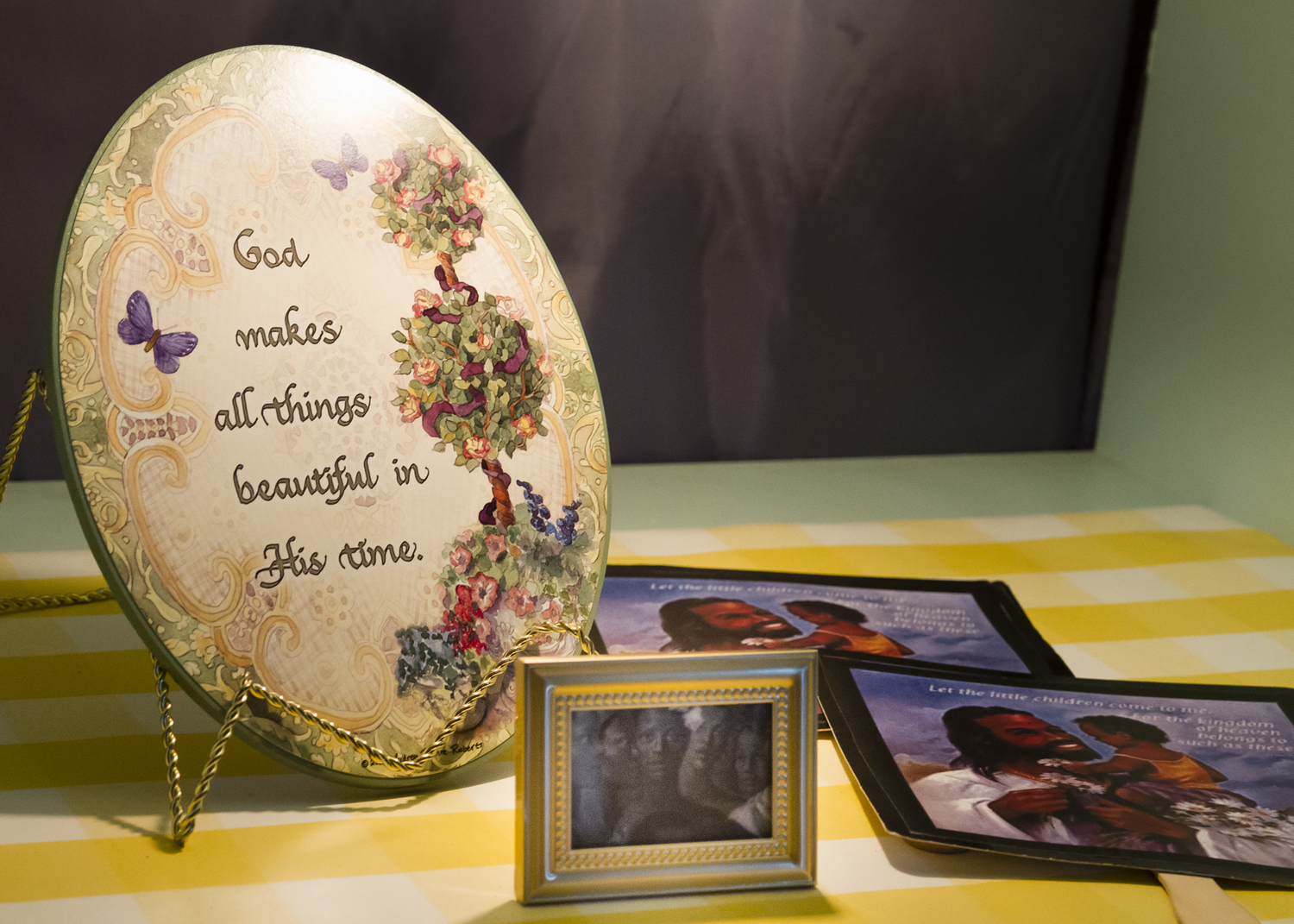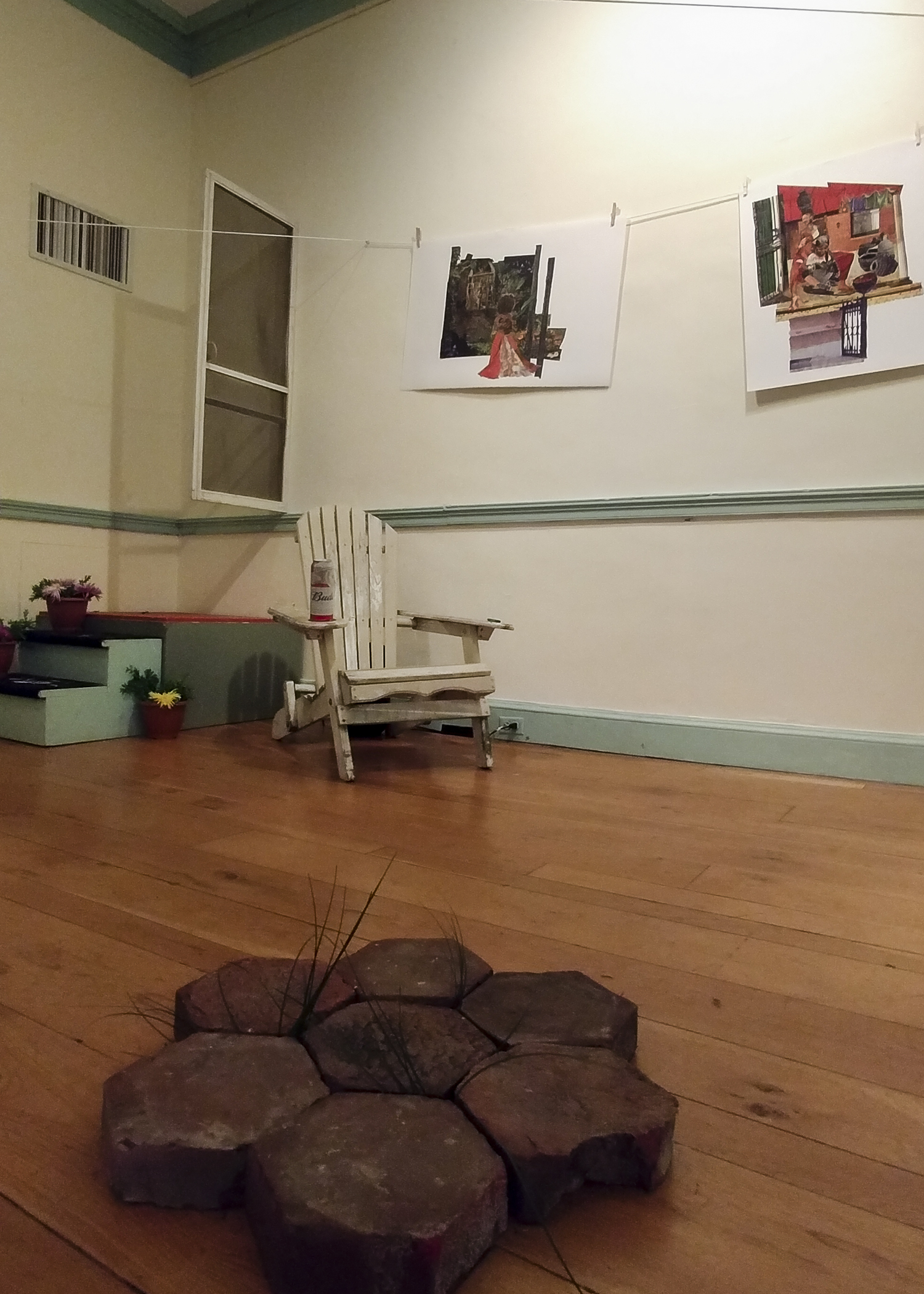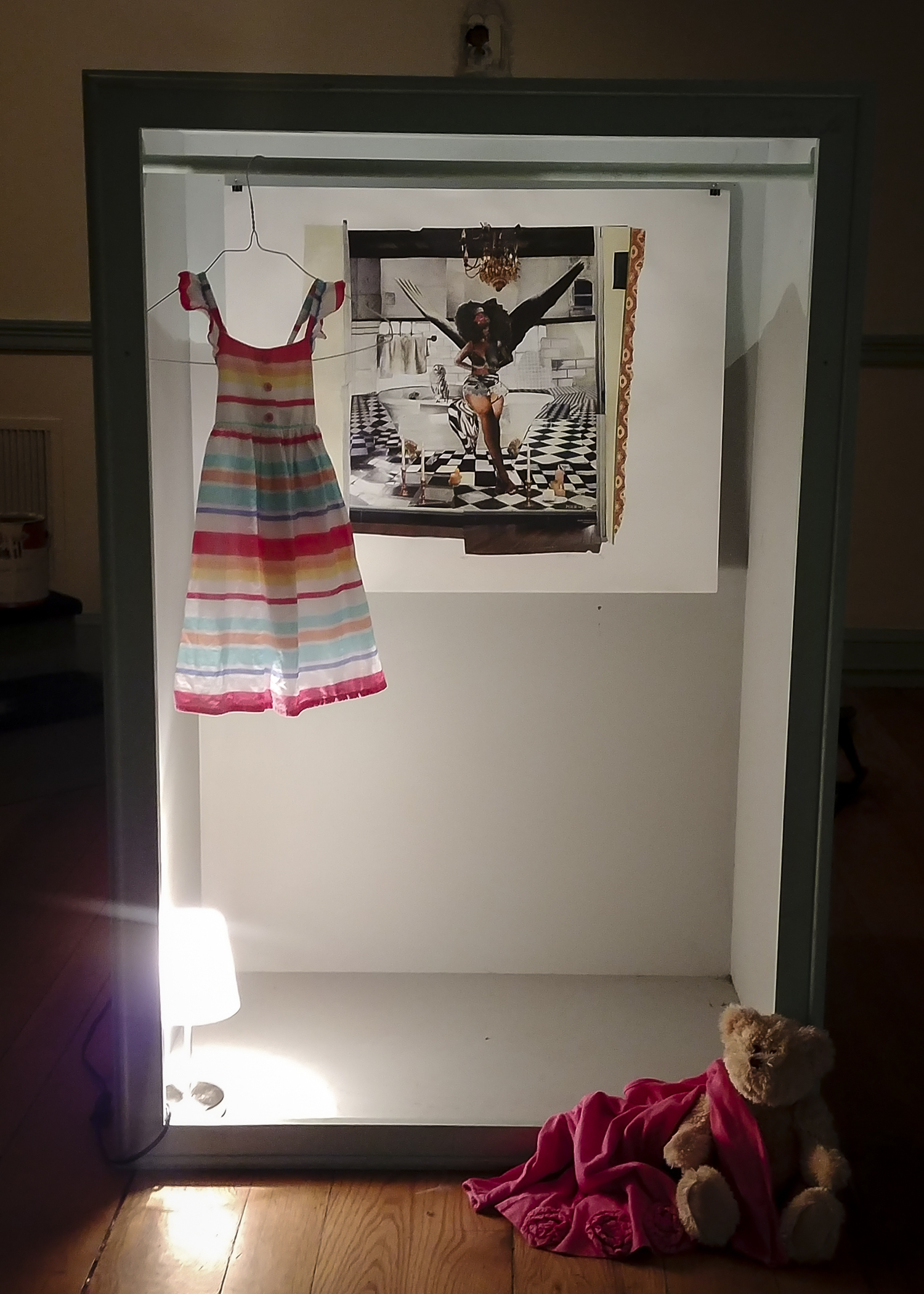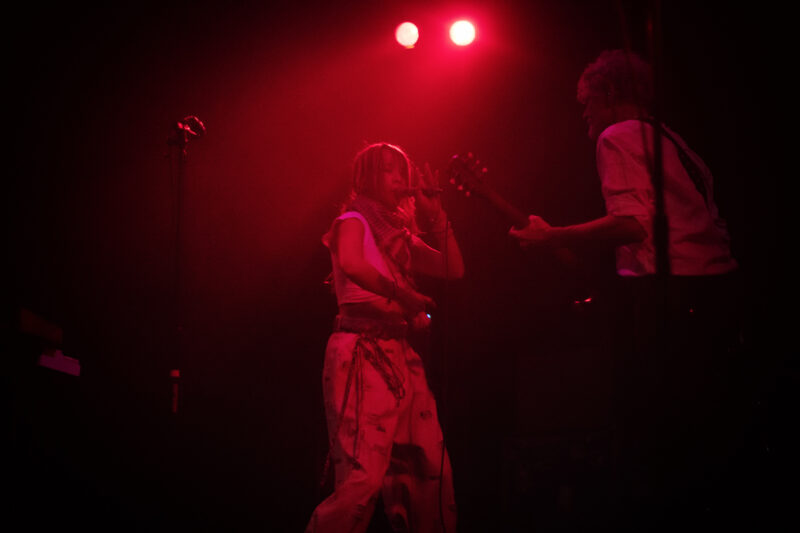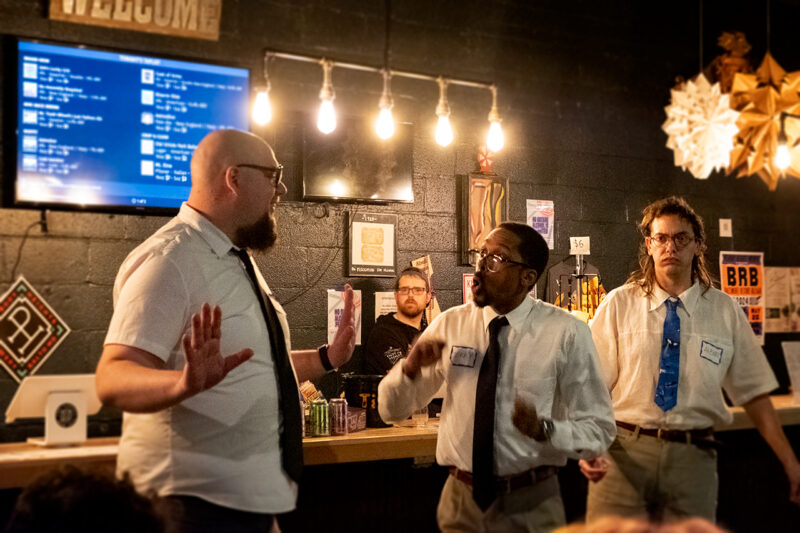BootPrints: Standing Room Only at the Peale Center is an Immersive Experience in Black Memory by Angela N. Carroll
“God specting womens to lay down and gurd up. Womens have to take boots on ‘deir chest and dress shoes, sneakers and cleats too. Women like carpet—all kinds of shoes gotta walk on womens.” – from BootPrints
Latonia Valencia-Moss’s dramatic play, BootPrints, is an unsettling but familiar narrative about death, family secrets, and the revelations of those who survive. BootPrints unpacks Black memory and the frustrations of younger generations who grapple with the histories, traditions, and secrets they have inherited. The perpetuity of Black mourning, Black grandmothers, labor, lace and wide-brimmed hats. Silk and sore backs from working as housemaids, Gmama’s hands, Sunday mornings, all these memories come into focus when Gmama dies. Her granddaughter Myeshia is left mourning her loss and remembering the impact of her grandmother on her life.
The play opens on Myeshia in conversation with her alternate personality Gingel as they determine what outfit to bury Gmama in. Gmama had a vast collection of colorful suits and each marked a significant event in the women’s lives: miscarriages, molestation, wealth, abandonment, love, failed marriages, poverty. As Myeshia/Gingel and Gmama’s apparition sort through the suits, they share their memories aloud as epic choreopoems. Like Ntzoke Shange’s timeless homage, For Colored Girls Who Have Considered Suicide When the Rainbow Is Enuf, BootPrints uses color, fashion and domestic interiors as cues for the emotional and psychological states of its protagonists. The play honors and humanizes narratives about southern Black women.

Director Nate Couser and Curator Tiffany Jones reimagine the theatrical script as an immersive installation series BootPrints: Standing Room Only at the Peale Center. The installations convert the second floor of the museum into surreal visualizations of Gmama and Myeshia/Gingels memories. Photographs, prints and collage works from Brianna Faulkner, Antonio McAfee, and I Henry Phillips are incorporated into and/or placed opposite the installations.
In all instances, Jones’ installations provide powerful imagery that enunciates key moments in the play and offer new perspectives about Black women’s lived experiences. Each installation tugs at the senses. Visitors can take lollipops or mints from any of the many candy dishes spread around the museum/Gmama’s house. You may smell the sweet dense aroma of incense or the pungent funk of moth balls. You will hear the voice of Gmama, Myeshia and Gingel tell their own stories through looped audio projections. You will surely leave the experience inspired.
Excerpts from Scene Ten (Yellow)
Myeshia:
You can’t ignore something yellow.
When it’s right in front of your face.
My grandmother was always in my face
You gotta slow down.
Yield.
Pay attention.
Pay attention to your heart.
Yellow.
Pay attention to your heart.
Faulkner’s Canary Girl, a mixed media collage hangs at the center of the yellow installation. The image shows a young black girl running, her face a wide grin, her arms outstretched like wings. She runs past a bright blue fence and blocks of rowhomes. Her yellow dress and long ponytail flap in the wind. Canary Girl is surrounded by small shelves. Each shelf contains objects that recall the mood and essence of yellow: bananas, jewelry boxes, flamboyant church hats, tambourines, fans with images of a beaming Black Jesus. An excerpt of Myeshia recalling yellow with joy and sobering reflections about Gmama’s words of warning she calls “yellow cautions” play in the background.

Canary Girl is one of twelve contributions from Faulkner, pulled from the series The Beautiful Wilderness and Women Waiting. Each of Faulkners collages revere the power of Black women’s domestic spaces, the innocence of Black girlhood and the sacred intimacies of sisterhood. Many of the collages, like Said and Done, a portrait of three women sitting in a kitchen, or Basket Makers, a vivid portrait of a mother braiding her daughters hair, read like scenes from the recollections of Gmama or Myeshia/Gingel’s monologues.
During a brief interview, Jones shared that viewing Faulkner’s work inspired her curation of the exhibition: “I wanted to create something people could relate to, especially Black women and Black families. [BootPrints] is all about secrets. You aren’t sure you can touch it. How close are those secrets? Brianna’s work is like that, you have to get close to see what’s in the image.”
Excerpt from Scene Ten (Yellow)
Gmama:
I brought that yellow suit causing I wanted to be seen
I feel invisible like nobody can see the tears
Bathing my body trying to cleanse the stains off my soul
Sometimes life wuz fur rethinking some things.
Jones culled the Phillips archives to select from thousands of photographs taken by I Henry Phillips Sr. documenting Black Baltimoreans from the 1950s. An untitled portrait is installed adjacent to Canary Girl and the yellow objects. The photograph centers on a woman who is lost in contemplation. A baby rests in her lap. Two toddlers anchor her sides and sit on the laps of two older children. The baby and eldest child, who wears glasses like his mother, stare directly at the camera. The woman stares sullenly at the floor, beyond the floor, the photographer and children.
I wondered who the woman in Phillips’ portrait was and the life she lived outside of caregiving. She could be my grandmother, or Gmama if all her miscarried children had survived. Gmama believed that “Dreaming is something Black folks can’t afford.”

I wondered what yellow cautions the woman in Phillips’ portrait worried over. Generations of Black women have been forced to feed children they did not birth. What dreams were swallowed, what possibility silenced to nourish other people’s children, and their own, and the hungers of the fathers of those children, and the cravings of other men, and still have strength to take on the horrors and wonderment of the American South?
Five of Phillips’ other untitled portraits accompany other installations throughout the exhibition. The juxtaposition of her historic black and white photographs with Faulkner and Jones’ dreamlike collages and assemblages, provides a realist weight that grounds the work in history, while still nodding to the recurrence of Black spirituality throughout the exhibition.
Excerpt from Scene Two (Black)
Gingel:
I love the way wez sound all incorrect and proper at the same time.
Don’t mean wez ignant dat’s what people’s think douh…
Gmama said, “wez just foreigners like all the other foreigners in America.”
Down south we knows the truth.
Antonio McAfee contributes three digital prints from the Through the Layers series (Mamie, Sonja, and General) and three digital prints from the Counter Archive Project (Oval #9, Oval #8, Oval #7) to the exhibition. All of McAfee’s prints are installed in the Peale Center’s theatre. The stoic portraits, memorable for their red and blue stereoscopic style, or ghostly black and white layered imagery, revise flat representations of African Americans in the early nineteenth century. McAfees’s unique process is akin to collage in its incorporation and modification of photography.
By evolving formal photographic processing techniques into digital manipulated formulations, McAfee queries the implicit biases and presumptions that weight histories of Black portraiture. McAfee’s prints are a wonderful compliment to BootPrints the theatrical play. Each of his portraits accentuate the complexity of Black identity and further establish the importance of Black women’s narratives.
Excerpt from Scene Twelve (White)
Myeshia:
Home
White
Peace
Serenity
My grandmothers love for us
was pure
BootPrints: Standing Room Only is extraordinary, palpable and deeply moving. The dual exhibition and reading is an experimental foray into immersive theater. On Thursday May 31st, under the Direction of Nate Couser, actors Ama Brown (Gmama), Jaye Nicole Wallace (Myeshia) and Sheena Barksdale (Gingel) will perform a live staged reading of BootPrints. That performance will mark the 10th anniversary of the staged production of the play.
“It’s not just a women’s story,” Couser offered, “this play is a big trigger, a number of triggers, but we [want to] push this experience to the next level. We want to see the play in a different way, and have it be experienced in a different way.” Couser and Jones hope to one day evolve the play further by developing it into a feature length film.
Tickets and more info here: https://www.eventbrite.com/e/bootprints-staged-reading-tickets-46108835769


